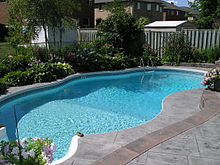Swimming pool
**Historical Evolution of Swimming Pools**:
– The Great Bath at Mohenjo-Daro in Pakistan dates back to the 3rd millennium BC.
– Ancient Greeks and Romans utilized pools for various activities, including training and military exercises.
– The first heated pool was constructed in Rome by Gaius Maecenas between 38 and 8 BC.
– Swimming pools gained popularity in Britain in the mid-19th century, with the Maidstone Swimming Club formed in 1844.
– The modern Olympic Games in 1896 contributed to the spread of swimming pool popularity.
**Types and Dimensions of Swimming Pools**:
– Swimming pools can be indoor or outdoor, in-ground or above-ground, and come in various sizes and shapes.
– Pool lengths vary, with standard sizes being 25 yards (SCY), 25 meters (SCM), or 50 meters (LCM).
– Pool depth varies based on usage, with private pools typically shallower than public pools.
– Pools for different purposes have varying depths, such as diving pools being deeper than children’s play pools.
– Most pools are measured in meters worldwide, with the US commonly using feet and yards as units of measurement.
**Modern Uses and Facilities of Swimming Pools**:
– Swimming pools are common in health clubs, fitness centers, and private clubs.
– Many municipalities provide pools for public use, both indoor and outdoor.
– Hotels, subdivisions, and educational facilities often have pools for guests, residents, and students.
– Hot tubs and spas are pools used for relaxation or hydrotherapy.
– Specially designed pools cater to diving, water sports, physical therapy, and lifeguard/astronaut training.
**Record-Breaking Swimming Pools**:
– The San Alfonso del Mar Seawater pool in Chile is the largest swimming pool globally.
– Deep Dive Dubai holds the record for the world’s deepest swimming pool at 60 meters.
– The Y-40 pool in Italy held the record until 2021.
– The Fleishhacker Pool in San Francisco, once the largest heated outdoor pool in the US, closed in 1971.
– The largest indoor wave pool is located at DreamWorks Water Park in New Jersey.
**Specialized and Unique Swimming Pool Designs**:
– Infinity pools create a visual effect of water extending to the horizon.
– Natural pools and ponds use biological filters and plants for cleaning without chemicals.
– Suspended swimming pools, like the Sky Pool in London’s Embassy Gardens, offer a unique swimming experience.
– Ocean pools, developed in the early 20th century, provide security against rough surf and sea life.
– Exercise pools, known as swim spas, have gained popularity in the last two decades for resistance swimming.
A swimming pool, swimming bath, wading pool, paddling pool, or simply pool, is a structure designed to hold water to enable swimming or other leisure activities. Pools can be built into the ground (in-ground pools) or built above ground (as a freestanding construction or as part of a building or other larger structure), and may be found as a feature aboard ocean-liners and cruise ships. In-ground pools are most commonly constructed from materials such as concrete, natural stone, metal, plastic, composite or fiberglass, and can be of a custom size and shape or built to a standardized size, the largest of which is the Olympic-size swimming pool.


Many health clubs, fitness centers, and private clubs have pools used mostly for exercise or recreation. It is common for municipalities of every size to provide pools for public use. Many of these municipal pools are outdoor pools but indoor pools can also be found in buildings such as natatoriums and leisure centers. Hotels may have pools available for their guests to use at their own leisure. Subdivisions and apartment complexes may also have pools for residents to use. Pools as a feature in hotels are more common in tourist areas or near convention centers. Educational facilities such as high schools and universities sometimes have pools for physical education classes, recreational activities, leisure, and competitive athletics such as swimming teams. Hot tubs and spas are pools filled with water that is heated and then used for relaxation or hydrotherapy. Specially designed swimming pools are also used for diving, water sports, and physical therapy, as well as for the training of lifeguards and astronauts. Swimming pools most commonly use chlorinated water, or salt water, and may be heated or unheated.
